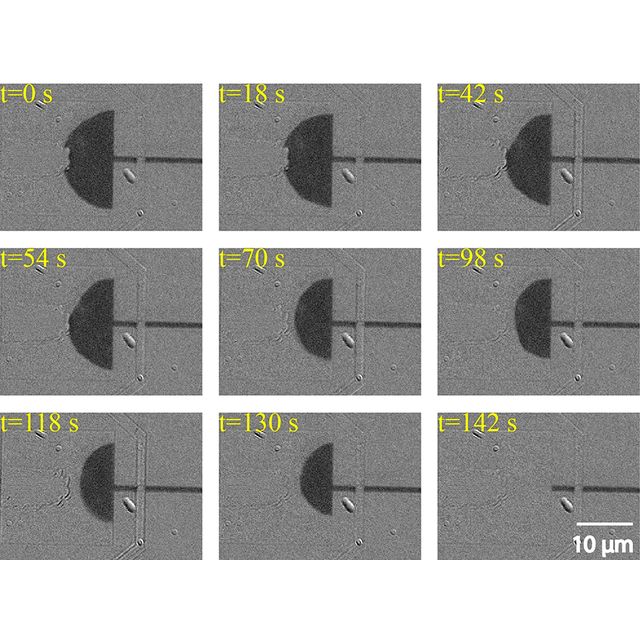Physicists have studied thin films of magnetic material and applied concepts of the physics of soap bubbles. With this approach, which had been barely used so far, they were able to explain new phenomena.
There is a very interesting analogy between the physics of magnetic thin films and those of soap bubbles: in both cases, it is possible to think in terms of interfaces, in terms of energy associated with the surface area of these interfaces, and in terms of difference of pressure on both sides of an interface. In thin film physics, the soap film is replaced by the magnetic domain wall, which separates two areas in which the magnetization is uniform. The pressure of the gas contained in the soap bubbles is replaced by the action of the applied magnetic field (B), which creates a difference of pressure (with a value equal to 2MB, where M is the magnetization density). These basic concepts were used by the soap bubble specialists and allowed the researchers to explain in a simple way many properties observed so far. In the case of magnetic thin films, despite its strengths, this approach had been barely used so far.
Researchers from the Centre de Nanosciences et de Nanotechnologies/Centre for Nanoscience and Nanotechnology - C2N (CNRS / Paris-Sud University), in collaboration with Beihang University in China and the Spintec laboratory (CEA/CNRS/Univ Grenoble Alpes), have observed phenomena similar to those known for soap bubbles in ultra-soft films of CoFeB, and they could demonstrate the soap bubble analogy. To begin, they found that magnetic domains of semicircular shape were not stable without a field. This first effect is explained by the Laplace pressure induced by the curvature of the domain wall, which tends to reduce the radius of the semicircular domain it delimits. By determining the external field that must be applied to stabilize the domain, they were able to determine the interfacial tension energy associated with the domain wall. They were also able to observe the repulsion between two domains almost in contact: in a way totally analogous to the classical experience of soap bubbles in contact, where the big bubble "eats" the little one, the big domain crushes the little one. Their work was published in the journal Physical Review Applied.
With the approach adopted here they could also explain a very common magnetic domain wall pinning phenomenon, which occurs at an abrupt widening of the nanowire section. This trapping is explained by the interfacial tension force applied at the enlargement, which tends to hold the wall and must be overcome. The measurement of the field required to depin appears as a second method to directly measure the interfacial wall energy. This energy is a very important parameter, but remains to access because the potential experiments to measure it are likely to be distorted by formidable artifacts, which means artificial signals related to the experimental method which cause an error of analysis. The current experiments offer at last a reliable measurement method, with a simple and intuitive understanding of the phenomena.
Figure : Kerr images (dark parts correspond to the reversed magnetization area) showing the spontaneous collapse of the half bubble after its creation using a pulse of magnetic field applied at time t=0. The time of acquiring for each picture is given at the top left of each picture. After the field pulse, during all this process, the magnetic field was zero. From X. Zhang - C2N (CNRS/Univ. Paris-Sud)Reference:
Direct Observation of Domain-Wall Surface Tension by Deflating or Inflating a Magnetic Bubble
X. Zhang, N. Vernier, W. Zhao, H. Yu, L. Vila, Y. Zhang and D. Ravelosona
Physical Review Applied (2018)
DOI: doi:10.1103/PhysRevApplied.9.024032
- Centre de Nanosciences et de Nanotechnologies – C2N (CNRS/Université Paris-Sud/Université Paris Diderot)
- Fert Beijing Institute, School of Electronic and Information Engineering, Beihang University, China
- Unité Spintronique et technologie des composants - SPINTEC (CEA/CNRS/Université Grenoble Alpes)
Contact :
- Nicolas Vernier, Associate Professor Université Paris-Sud at C2N









